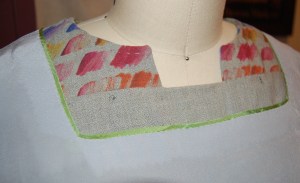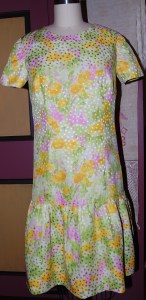Linings seem to be coming out of the (fabric) closet and finally getting the recognition they deserve! I have been thinking a lot about linings lately, as I have been working on a coat, the lining for which was its inspiration.

I made a cocktail dress out of the blue fabric and purchased enough extra yardage to use for the lining of a coordinating coat.
As luck would have it, the current issue of Threads Magazine has an article on techniques to achieving “A Smoother Jacket Lining,” which states “the secret is installing it by hand.” I always appreciate an illustrated step-by-step approach to techniques such as this, and this article by Daryl Lancaster does not disappoint. While I am well versed in sewing in linings by hand, it is always good to read a refresher article such as this. (Obviously, the alternative to sewing in a lining by hand is to bag the lining, effectively sewing the lining in by machine.) I also always seem to gather one helpful tip, such as “Easy access to the armhole seam: Reach through the openings at the front hem to support the sleeve lining while you’re hand-sewing the armhole seams.” But what I really liked about this article was the section on “Fabric Guidelines.” In a nutshell, the author lists them as: “a low-friction surface; a supple hand; opacity; durability; and design compatibility.”
Design compatibility! This means, according to the author: “The lining should complement the garment. It can match or contrast. Lining offers the opportunity to subtly show the wearer’s creativity.” EXACTLY!
Many of us, I think, grew up or learned to sew with the idea that linings should match the color of the outer garment as closely as possible. And while that is still appropriate in many instances, there is also a case to be made for linings of contrasting or coordinating colors, and/or figured designs. In fact, I believe a lining has the potential to turn your garment from ho-hum into tres chic.
One of the best examples of the power of a lining is the classic little French jacket. Pictured here are the two I have made for myself (with two more planned.) Imagine the one on the left being lined in a plain black or red charmeuse, and the one on the right lined in a solid light brown. Neither would be nearly as attractive even though the lining does not show when the jacket is being worn. As it turned out, I made a sheath dress, which matches the lining of the red jacket, and a blouse to match the lining of the jacket on the right. This makes the lining an integral part of the all-over design of the ensemble.
Likewise, this Pucci silk sat in my fabric collection for a few years until I found the right pattern for it. Then I became obsessed with somehow working out a way to line the jacket and make the dress out of the scant existing yardage I had.
The nice thing about this jacket is that it does not have to be paired with the dress, looking equally as nice with a plain pink skirt. Which leads me into the next thought: sometimes it is more appropriate for your lining to be subtle in order to make your garment more versatile. When I made a linen coat last year, I would have loved to use a deep pink lining silk to match the linen dress I knew I would be wearing with it. I chose, instead, to match the lavender of the coat, making it easier to wear with other dresses or pants, which might not have any pink in them. To make it a little extra special, however, I added flat silk piping to the front edges of the lining. Because coats come off and on, and sometimes find themselves flung over chair arms, this little detail is often seen by more than just the wearer.
Then there are the linings which truly are only seen by the person wearing the garment – you or I. Is it worth the time and/or expense to create a special lining in something like this? Every situation should be evaluated on its own merits, but I believe this is where the privilege of being your own dressmaker is in full flower. Why not add a little detail or use a beautiful, contrasting color to coordinate with your fashion fabric?

I used a gray Bemberg lining for this dress, but accented the neck edge with green piping. Obviously, no one sees this but me!

And who would guess that under this dress is . . .
In sewing (as in life) it is often the hidden treasures or small gestures which add depth and enjoyment to the process and product. May your hidden or not-so-hidden linings be beautiful every time!






